Why is Organic Traffic Decreasing? Reasons & How to Fix
Key Takeaways
- AI Overviews (AIO) by Google are significantly impacting organic traffic, with them appearing in around 47% of search results, up from 25% previously.
- Informational intent articles face significant traffic reductions as AIO triggers 99.2% of "what is" queries.
- Commercial queries are also affected, with AI Overviews triggered in 8.69% of searches, leading to a decline in traffic for those pages.
Editor’s Note: This post was originally published in January of 2024 and has been updated for accuracy and comprehensiveness.
For this business owner, usually gets around 450k unique visitors every month. That has changed now. They lost over 40% of their traffic, and the decline is affecting revenue.

The obvious answer to why they lost organic traffic is the launch of AI Overviews (AIO), which is Google’s way of saying “don’t click on any of the ranking pages. Here’s the answer you’re looking for.”
Case in point:
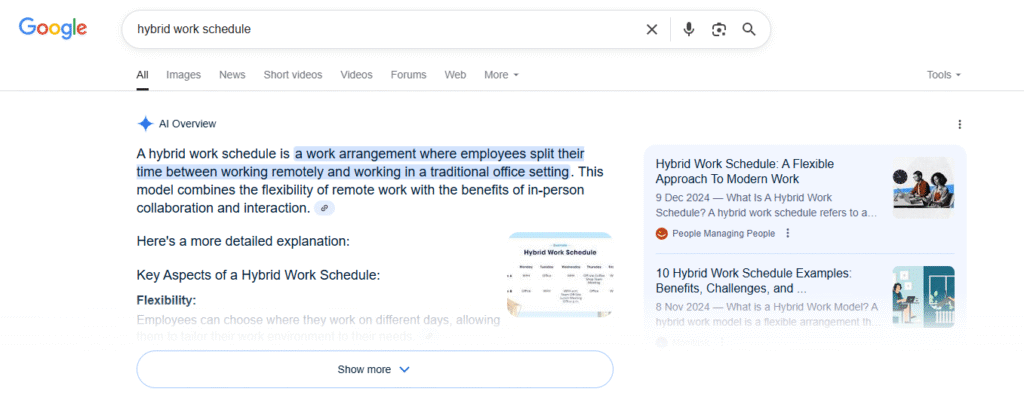
Traffic to articles with information intent is nerfed due to AIO. It’s triggered 99.2% of the time a user types a “what is” query.
We’ve seen that this extends to commercial queries as well. AI Overview is now triggered for commercial queries 8.69% of the time.
Overall, AI Overviews appear in roughly 47% of search results now, up from 25% in mid-2024.
As expected, it’s affecting businesses:

However, what if, aside from AIO, there are other reasons for organic traffic decline? That’s what we discuss in this article.
What is the root cause of the decline?
Organic traffic decline can be because of AIO, a Google core update, or a technical error on your website.
The quickest way to know why traffic is down is to look at your performance report on Google Search Console or use third-party tools like SEMrush and Ahrefs.
Take a look at the charts. How does it look? Is the decline steady or irregular?
Here’s a rough sketch from Google to help you guess what went wrong.
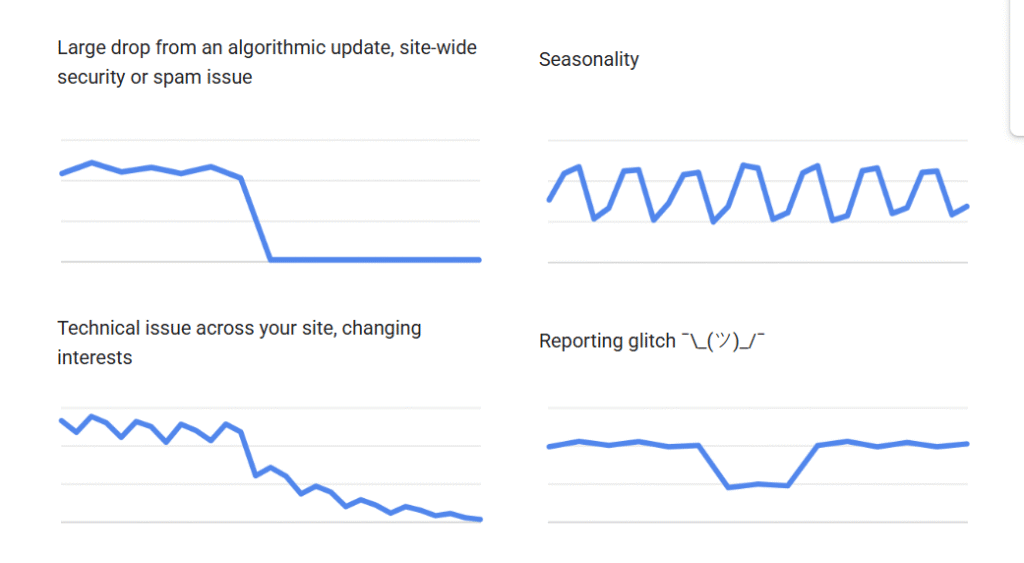
- If it’s the top left chart, it’s probably an algorithmic shift. It can be a page-level technical issue (e.g. unintended noindex tag, which means Google can’t crawl the page(s). Also, Google regularly improves how it evaluates content, so core updates may change how some of your high-traffic pages perform on Google.
- If the traffic decline looks like what’s on the top right chart, it’s seasonal traffic shifts. This is common to ecomm business with seasonal products. It can also be caused by weather changes, holidays, or vacations, as people aren’t visiting your site as regularly.
- If it’s the bottom left chart, it’s a technical issue affecting your whole website. These are issues that prevent Google from crawling, indexing or serving your pages to users. In most cases, it means your website is down or many of your high-value pages are suddenly inaccessible.
- If it’s the bottom right chart, it’s reporting glitches. It means there was a major decline in traffic which then returned to normal patterns (as seen above). It’s a glitch, and you don’t have to worry.
To know which it is, head to your Google Search Console and analyze the patterns to be sure.
Google recommends going as far back as 16 months so you can trace the rise and fall of your traffic:

Result:

Compare the last three months year over year or the last three months YOY. This will help you understand what went wrong and when it started.

Also, check if the decline is a site-wide issue or a page-level issue.
Click the “Pages” section on your performance report, and select the same date difference (the same month last year or the same day last week) to compare the traffic trend.

This will help you troubleshoot the reason for the decline in traffic, and you can take actions accordingly.
7 reasons why your organic search traffic decreased incredibly
This isn’t an exhaustive list, but it’s worth paying attention to. That’s why I recommend you speak to an SEO professional to audit your webpages to give a proper diagnosis of what happened to your website.
1. AI Overviews (AIO), AI Mode and zero-click searches
Zero-click search/content is the concept that users want value from the page they’re in without clicking any link to another page.
If they don’t get what they want, they scroll, check another platform, or try another search query. If they’re on social media, they’ll scroll. But on Google, they may eventually click on a page or use chat bots.
Since Google introduced AI Overviews, some companies have lost 20-40% of their organic traffic. Some had up to 56% drop in CTR (like news websites, MailOnline).
This means that even if you do everything right, AIO will reduce clicks to your website, which will then reduce your overall organic traffic.
What can you do to optimize for AIO and other zero-click features on Google?
Optimize your content with long tail Q&A sections. You can make these specific H2s, H3s or dedicated FAQs where you can answer common queries.
We currently optimize our clients’ content for long tail keywords. These are question and answer type of query, so that AIO can summarize our content in its response:
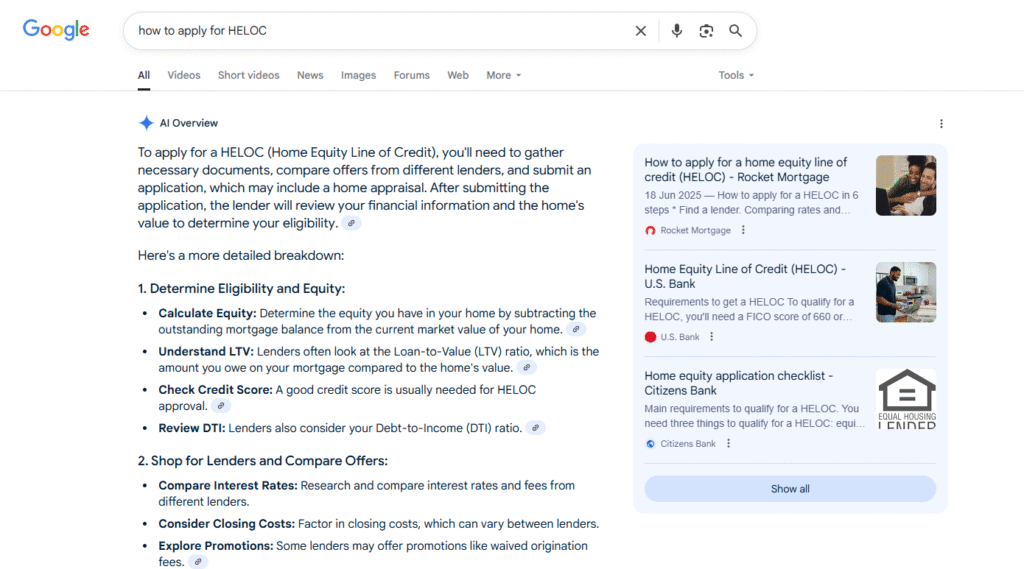
We also try to answer the question first, then explain.
So if our heading is “What is the root cause of the decline?” The next sentence is the answer: “Organic traffic decline can be because of AIO, a Google core update, or a technical error on your website.” You can see this in our previous section.
While this doesn’t lead to clicks to the website, it increases visibility, especially if the searcher expands the source list.
If the searcher wants to learn more about what they’ve read, there’s a direct link to our client’s website.
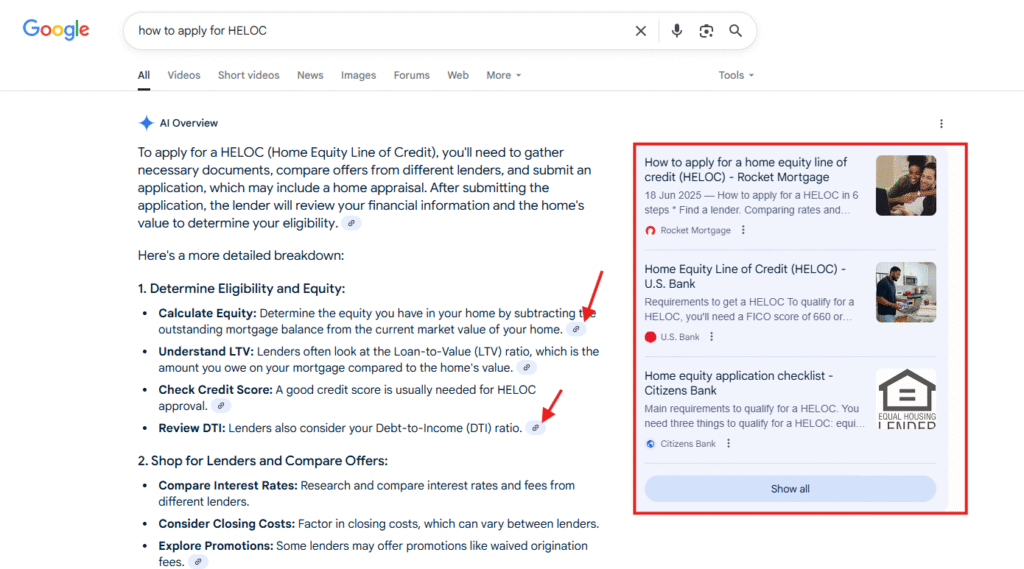
To find some of these long tail keywords, use the People Also Asked box,

Or use third-party tools like SEMrush and Ahrefs to analyze your primary keywords.
📌Read more: how to optimize/rank for AIO.
2. The rise of AI search engines
Chat bots like Chat GPT, Claude AI, and Perplexity AI now answer questions without directing users to click on any website.
In fact, Open AI now allows users to shop on Chat GPT. Users can type a query like “best noise cancelling headphones under $200” and receive product suggestions with prices, reviews, and direct purchase links:

This means that some of the 180 million active users of Chat GPT may decide to shop, ask questions they would normally google, and get immediate answers without relying on Google or the websites that created the content they’re consuming.
In total, there are over 987 million people using chat bots globally. This will reduce traffic to your website, even if your pages are well-optimized to rank on Google.
What to do to increase mentions in LLMs.
We advise our clients to optimize their websites for mentions in LLMs.
This means we prioritize content that can increase their brand visibility and mentions in LLMs.
This way, when a user searches for best headphones under $200 or best coffee maker within $X range, our client will be mentioned.
And when they’re mentioned, the user will get a direct link to learn more about any of the products that spike their interest.
This is why although Google is losing traffic, well-optimized content that shows how you can help your reader will still help you convert those readers.
So which type of content should you create to be noticed by chat bots (and even AI Overview)?
- Target category keywords: These are keywords relating to your business category that people are looking for. For example, “best coffee makers,” cotton joggers for men,” or “project management software.” If you want to take it a step further, be more specific and optimize for “best coffee maker under $300.”
- Target comparison, alternatives or “best xyz” content: This is where you compare your product (or brand) to a competitor’s. This is common in B2B SaaS content marketing, where you’ll see articles such as “Shopify vs Wix for small business owners,” “ClickUp vs. Monday.com for project management” or “best e-commerce platforms for small businesses.”
However, an e-commerce brand like Jibby also has a comparison table on its website.
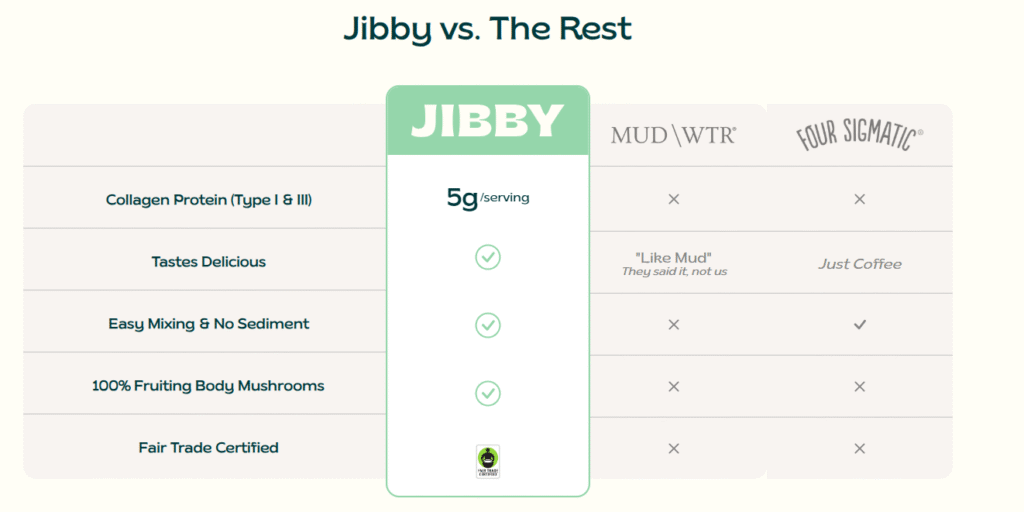
This kind of content helps you compare your product with your competitor’s product and write a near-objective verdict on how (and why) your product is better.
This helps you build PR on your website, and it can increase how AI chat bots mention and phrase the features of your products.
Case in point: the Anker Soundcore Space Q45 Wireless recommendation from Chat GPT earlier was directly pulled from a blog post published by Soundcore (the maker of the headphone).

Guess the title of the blog post? “Best noise cancelling headphone under $200.”
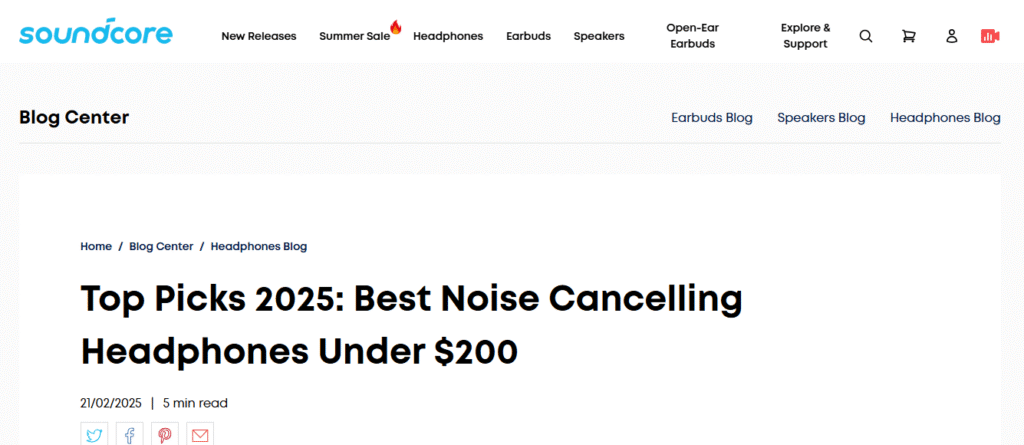
- Target buyer-intent content: this can also be called jobs-to-be-done content, i.e. content that addresses the pain points of your target audience. For example, “quick brewing machine for office,” or “easy coffee maker for busy mornings.” These are contents that when created, you’ll rank for them on Google. And when users ask these queries on chat bots, you also have a high chance of ranking for them because you’ve optimized your website specifically for those queries/keywords.
When you do these, be intentional about how you phrase your product, services, and features in your content.
This is because chat bots are language models, and they understand word association. So regularly associate your company with your product, the use cases, features, and the pain points it addresses for your target audience.
This way, even if AI chat bots are the driver of your decline in traffic, they can point back to you when users search for queries with commercial intent. Or are ready to buy.
If AI chat bots and AIO isn’t responsible for the traffic decline, here are other things to consider:
3. Search engine core updates
Search engines like Google and Microsoft regularly update their algorithms to provide users with relevant, informative, and quality information. This leads to regular core updates, which may favor some websites with higher rankings. Others will be slapped with a decline.
For instance, after the March 2025 core update, a user posted their massive decline in rankings.
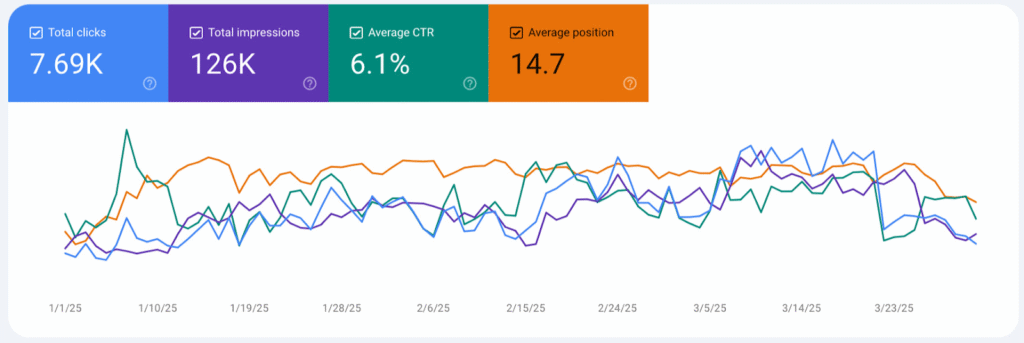
Instead, websites like Reddit, HomeDepot and Yelp got more traffic,
The update affected websites with overly AI-generated content that add no value. Google also penalized repetitive AI content and emphasized human-first, original content.
What to do after an algorithm update affects your organic traffic:
Read the details of the update from reputable sources like Search Engine Journal or Google’s web admin’s blog. You can also follow people who post first-hand information, such as John Mueller, Google’s search advocate, or Addy Osmani, senior staff engineering manager for Google Chrome or Barry Schwartz, news editor at Search Engine Land.
While analyzing the details, check if your website needs to be improved based on the update.
If there was a crackdown on spam links, audit your backlinks and delete shady ones to keep your website fresh.
If there was a crackdown on AI-generated content, audit your content library and rewrite the affected content.
If there was a crackdown on old, outdated content, delete some pages and update important ones to restore their organic traffic value.
You can also consider these recommendations:

4. Your site is experiencing technical SEO errors
This means Google can’t crawl, index or serve your pages to web users. And if it goes on for days or weeks unnoticed, you’ll notice a decline in traffic that looks like this:

These technical SEO issues may be because of problems like
- Canonicalized tags.
- Broken redirects.
- Unintended Noindex tags.
- Etc.
What to do if there are site-wide technical SEO issues:
Use Screaming Frog, or even our free SEO Grader, to audit your website and discover issues affecting it. With technical SEO, many things may be wrong with your website, but you can prioritize some problems over others just like Aleyda Solis, former head of digital strategy at Woorank, says:
“When conducting an SEO audit, ensure that the pages you want to rank for are crawlable and indexable. In my case, it’s all about priority and impact, i.e., high-priority, medium-priority, high-impact, medium-impact. I remove low-priority, low-impact from my audit; you can always disregard it. But I will always concentrate on things that have high priority, high impact, and medium priority, medium impact.”
For context, you can prioritize page speed because a slow site can lead to high bounce rate. Users won’t wait around for more than three seconds for your website to load (and this may reduce your traffic because high bounce rate tells Google bots the page isn’t helpful).
Also, you can choose to optimize your website for mobile-friendliness over fixing sloppy alt text on non-critical images.
You can also prioritize resolving major navigation or UX issues. These are technical SEO issues that if unresolved, can affect user experience and reduce your website traffic.
To make all these easier for you, you can hire a marketing agency like HigherVisibility for your technical SEO needs. We will audit your webpages, backlinks, and show you a detailed report of what went wrong and how we can help you fix it. Hit this link and make a toll-free call or write an email to speak with one of our experts.
5. Competitor improvement
Another vital reason why your site could be failing is because your competitors have upped their game.
In some cases, your content might be better (in terms of quality). But they might be doing something differently.
What to do to compete with others in your industry:
Conduct an in-depth competitor analysis to find opportunities to perform better. Look into their keyword strategy, backlink profile, and traffic sources. Use third-party tools like SEMRush, SpyFU, and Ahrefs to find this data.
In an interview with the SEMRush’s team, Stefan Dobois, CEO of SurveyAnyplace, disclosed that they use the information obtained from their competitor audit to:
- Select topics & keywords for their articles based on a competitor page that gets a lot of organic traffic.
- Reach out to websites that generate a lot of referral traffic for a competitor, and see if they can link to their website as well.
- Make decisions about the translation of content: which content to translate into which language based on competitors’ organic traffic numbers in non-English languages. This is especially important if you have a product (and visibility) in multiple markets.
Also, Ben Kazinik, former director of marketing at Mayple, explains how you can milk the juice in your competitor strategy to get more backlinks:

You can follow this strategy as well to improve your backlinks. It’s still relevant in 2025.
6. Website redesign or migration
You can experience decline in traffic if you’ve recently redesigned your website or migrated to a new hosting provider. Here’s an example of a charity website. Their traffic tanked after a failed website redesign:

This traffic loss can be a result of many factors. But the most common factors are missing pages, missing or misconfigured redirects, and content changes.
For example, if you’ve recently migrated your site and the high-traffic pages are not properly redirected, users and search engines will not be able to access those pages. This will affect user experience and you’ll lose traffic from those high-value pages.
What to do after losing traffic because of a website redesign or migration:
In case of redirects, manually check all the affected pages in a browser to know if they redirect properly to a new page. Use ScreamingFrog to ensure they’re 301 redirects and not 302 temporary redirects. Also, check the redirected pages to make sure everything works end-to-end.
If you changed your page content during the redesign, monitor its performance over time to make sure it performs better than the previous version. Focus on key performance indicators such as user engagement metrics.
7. Seasonal trends
You can also lose traffic because of seasonal trends. This may happen because of weather changes, vacations, or holidays, especially if your products are seasonal products.
For example, if you recently concluded a black-friday sale, it’s not uncommon to experience a dip in traffic after the peak shopping period.
See a graph showing the seasonal search demand for ‘skis.’

You can use Google Trends to identify changes in consumer demand (for a particular product in your niche) and correlate them with traffic levels on your own website. This helps you know if the traffic decline is specific to you or it’s a general industry trend.
What to do with seasonal traffic declines:
The default next step is to wait until you get peak traffic again. But you can do something else:
You can conduct live customer interviews and surveys to understand what users do after the peak-traffic season. Do they need an extra accessory to the product they’ve bought? Can you partner with an affiliate brand so you can provide more value to users?
You can also use tools like Facebook Audience Insights or SparkToro to research consumer behavior, such as keywords used all year round and search channels. These can help you understand search behavior during peak seasons and slow seasons, and then create a strategy to maintain reasonable momentum while prepping for the next peak season.
Other tips to improve your search traffic in 2025 and beyond
1. Evaluate your current strategy
The first thing we do while onboarding a new client at HigherVisibility is to analyze their current strategy to identify areas of strengths and weaknesses. This helps us know what worked and hasn’t worked for them so we can improve bottomline revenue as fast as feasible.
Case in point, we onboarded RoadRunners Cigars, a cigar storefront company that needed our e-commerce services. They’ve been trying to increase organic traffic and revenue for years; they had less than 1k monthly organic visitors when they came to us.
To help them, we started with the foundation: their SEO strategy. What can they improve? Are they targeting the right audience? After thorough analysis, we discovered some issues with their technical SEO, so we had to remedy that first.
Next, we created a user-focused strategy using a proprietary method. This strategy covers content marketing, keyword research, conversion rate optimization so every customer touchpoint can nudge them to take action (buy or add to cart so we can send followup emails).
The results? Their traffic grew to over 4k YoY (250% increase in organic traffic) and 297% increase in organic revenue. Read the full case study here.
We can achieve the same (or better) result for your business. Hit this link to start the conversation.
2. Focus on your audience
Create a specific ideal customer profile and create content that targets them. We discussed the type of content to create earlier. Remember to target keywords such as:
- Category keywords.
- Comparison, alternative type of content.
- Buyer-intent or jobs to be done content.
3. Don’t ignore the basics
You should always:
- Keep your content concise, informative, logical, and authentic.
- Share your story. Use user-generated content, product reviews, customer testimonials, case studies, etc., to connect with your audience.
- While you build backlinks, don’t underestimate the power of internal linking. Link to other cluster pages (if you’re working on pillar content) and interlink contextually related pages to improve site architecture.
- Use visuals. They’re effective in communicating complex ideas and making your brand more memorable
Hire an SEO professional
Organic traffic decline is one of the dominoes of the launch of AI Overviews, and now, AI Mode. There may be six other reasons you’re losing traffic, and we’ve provided answers on what to do in this article.
If SEO isn’t in your wheelhouse, it’s cost-effective and time-saving to outsource your SEO to an expert. A good marketing agency has the experience and marketing/analytics software to find issues that lead to organic traffic decline. We also know how to take you from where you are to where you want to be.
Experiencing a decline in organic traffic? Our SEO experts can diagnose the issue and implement strategies to recover your traffic. Request a tailored proposal today and get your traffic back on track

Need Expert Help?
At HigherVisibility, we specialize in diagnosing and resolving traffic declines. Contact us for a custom audit and expert guidance to enhance your website’s performance.
